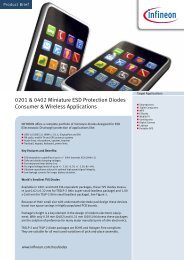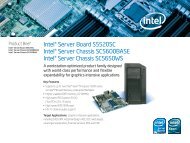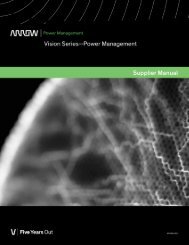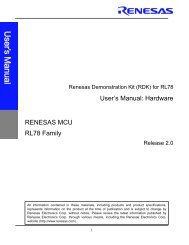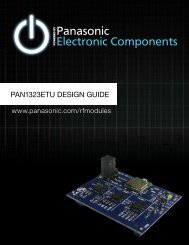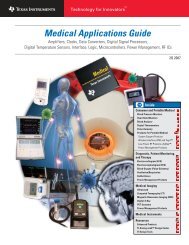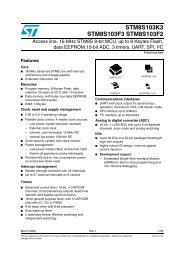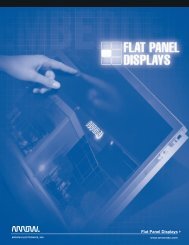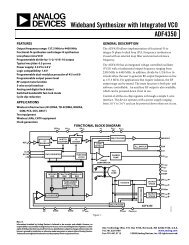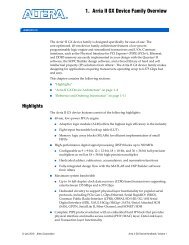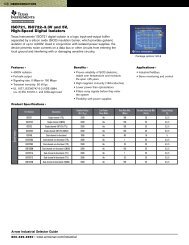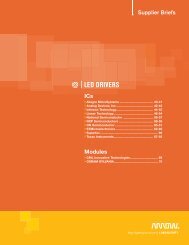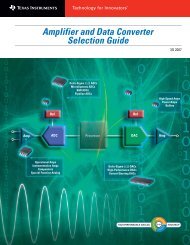Download Presentation - Arrow Electronics
Download Presentation - Arrow Electronics
Download Presentation - Arrow Electronics
Create successful ePaper yourself
Turn your PDF publications into a flip-book with our unique Google optimized e-Paper software.
How Long Will My Battery Last?<br />
Understanding system design for maximum battery life<br />
NXP Semiconductor
Overview<br />
– Energy efficient “green” products and battery-powered devices are<br />
becoming more common<br />
– Consequently, designing for optimum battery life and power efficiency is<br />
increasingly important.<br />
– How is the life of your battery dependent on far more than just the active<br />
power consumption of your components?<br />
2
Agenda<br />
– Active Power vs. Standby Power<br />
– Understanding power specifications<br />
– Understanding Duty Cycle<br />
– Application Example<br />
– The <strong>Arrow</strong> Oryx board<br />
– Detailed Power analysis by component type<br />
– MCU<br />
– RF<br />
– Interface<br />
– Logic and discrete<br />
Next Steps: recommendations for next generation Data Collection System<br />
Data Collection System Block Diagram<br />
– Summary<br />
3
Active vs. Standby Power<br />
– All devices specify maximum/typical<br />
– Active power consumption (device fully functioning)<br />
– Standby power consumption (device sleeping/standby and other modes)<br />
– Real power usage (Duty Cycle) measured by ratio of time spent in each<br />
of these modes<br />
– Examples Duty Cycle (Active/Total) for common battery power<br />
applications<br />
– Data collection system:<br />
– Transmitter Nodes: about 1%<br />
– Receiver Node (host): Similar (usually line powered)<br />
– Tablet computer: Varies depending on use<br />
– 100% for video streaming<br />
– Less than 50% for text input<br />
– Note that different components used for different operations<br />
4
Application Example<br />
THE ORYX BOARD<br />
5
Application Example<br />
– System Controller: <strong>Arrow</strong> Oryx Board<br />
6
ORYX Board Functional Block Diagram<br />
7
ORYX Board Functional Elements<br />
8
Power Supply<br />
How much power is there to work with?<br />
Power Source Options:<br />
– External (e.g. Solar with LTC3105)<br />
– From LPC11U14 USB Interface<br />
– From LPCXpresso pinning interface<br />
– From LPC-Link Debugger USB Interface<br />
Rechargeable Lithium Battery<br />
LIR2032 with 45mAh<br />
Battery<br />
Options<br />
9
Key Components Power Consumption<br />
Component Function Active Modes Low Power Modes<br />
LPC11U14<br />
ADXL345 on I²C Bus*<br />
PCF8523 on I²C Bus*<br />
Cortex-M0 Microcontroller<br />
with USB and Smart Card<br />
IF<br />
3-Axis Accelerometer with<br />
Dual IRQ for MCU wakeup<br />
Real-Time Clock with IRQ<br />
for MCU wakeup<br />
Max. 12mA (50MHz)<br />
Typ. 2mA (12MHz)<br />
Avg. 130µA / MHz<br />
Active Communication on I²C<br />
Bus: 150 µA<br />
Active Communication on I²C<br />
Bus: 200µA<br />
Deep Sleep: 360µA<br />
Power Down: 2µA<br />
Deep Power Down: 220nA<br />
Standby Typ. 100nA<br />
Time Keeping: 150nA<br />
LM75B on I²C Bus* Temperature Sensor Active Measuring: 100µA Shutdown Mode: 200nA<br />
PCF8885 on I²C Bus*<br />
AT45DB041D on SPI Bus<br />
LS013B4DN04 on SPI Bus<br />
8 Channel Capacitive<br />
Touch Sensor with MCU<br />
wakeup<br />
4 MBit serial Flash,<br />
separate Power switch<br />
96x96 memory LCD,<br />
separate Power switch<br />
Active 10µA<br />
Read 13mA (50 MHz)<br />
Page Program 22mA<br />
Erase: 24mA<br />
Sleep Mode: 100nA<br />
Auto Standby: 20µA<br />
Deep Power Down: 1.5 µA<br />
1 Hz Update: 4µA Standby: 2µA<br />
* There is an optional power control on the two I²C pull-up resistors. By disabling these, the power down current consumption of the I²C-pins of the LPC11U14 can be reduced .<br />
10
Min/Max Power Consumption Range<br />
LDO 3.0V<br />
I²C<br />
SPI<br />
All Components Active: 14mA / 42 mW<br />
MCU<br />
Power Switch<br />
Power Down Mode: 6.57µA / 21µW<br />
2µA<br />
Cap<br />
LCD<br />
Flash<br />
– MCU in Power Down<br />
RTC<br />
Accl<br />
2µA<br />
– (Brown Out Detect disabled)<br />
– LCD 0.5 Hz keep alive signal<br />
– RTC Time-keeping 120nA<br />
– Serial Flash OFF<br />
– Capacitive Sense & Accelerometer in Sleep Mode<br />
0.57µA<br />
Note:<br />
MCU Deep Power Down reduces<br />
consumption to 220nA but will Tristate IO-<br />
Pins (so nothing is done)<br />
Duty Cycle = 100%<br />
For Battery LIR2032 with 45mAh → 3.2 hours runtime (worst)<br />
→ 285 days runtime (best)<br />
11
Doing Something Useful:<br />
Analog Data Acquisition<br />
14 mA<br />
1. Read ADC Data<br />
20ms<br />
2. Read I²C Bus Temperature<br />
Sensor<br />
6.57 µA<br />
3. Update Display<br />
1s<br />
4. Go to Power Down Mode<br />
Average Current<br />
=<br />
( µA×<br />
20ms)<br />
14000 + (6.57µA×<br />
980ms)<br />
1000ms<br />
= 286.44µA<br />
Duty Cycle = 20/1000= 2%<br />
For Battery LIR2032 with 45mAh → 6.5 days runtime<br />
12
Doing Something Useful:<br />
Digital Clock<br />
14 mA<br />
1. Read Clock Data via I²C once<br />
per minute<br />
20ms<br />
6,57 µA<br />
2. Update Display<br />
3. Go to Power Down Mode<br />
60s<br />
=<br />
( µA×<br />
20ms)<br />
14000 + (6.57µA×<br />
59980ms)<br />
60000ms<br />
Average Current = 11.23 µA<br />
Duty Cycle = 20/60000= 0.03%<br />
For Battery LIR2032 with 45mAh → 166 days runtime<br />
13
Oryx Power Reduction Tips<br />
– Maximum Display Update Speed is limited by SPI Interface<br />
to 0.75Mbps<br />
– Set MCU speed to match max SPI speed<br />
– Any more performance is wasted<br />
– Only update parts of display that change<br />
– LCD draws most power when state of pixels change<br />
– Less Lines to update = less time to finish and go back to<br />
sleep<br />
– Don‘t blank it and reload each time: just update<br />
– Use external Brown Out detection<br />
– MCU internal BOR consumes +50µA<br />
14
Taking it to the Limits of Battery Life<br />
MCU ANALYSIS<br />
15
LPC11U14 Block Diagram<br />
Up to 40 GPIOs<br />
Power<br />
Profiles<br />
2 SSP<br />
USB<br />
Smart Card<br />
Interface<br />
16
LPC11U14 Feature List<br />
– ARM Cortex-M0 core @ 50 MHz<br />
– Memories:<br />
– Up to 32 kB Flash, 6 kB SRAM<br />
– Boot ROM<br />
– Power Profiles<br />
– Serial interfaces:<br />
– USB, 2 SSP, I 2 C-bus interface with<br />
Fast-mode Plus mode, USART with<br />
Smart Card Interface<br />
– Analog peripherals: 8-ch/10-bit ADC<br />
– Temperature range: −40C to +85C<br />
– Packages: 48-pin LQFP, 33-pin HVQFN,<br />
48TFBGA (4.5x4.5mm)<br />
– Other Peripherals:<br />
– Up to 40 General Purpose I/O<br />
– Four general purpose counter/timers<br />
– Programmable Windowed Watchdog<br />
Timer (WWDT)<br />
– 12 MHz internal Oscillator<br />
– Clock output function with divider<br />
– Brown-Out Detect (BOD) with<br />
4 thresholds<br />
– Boundary Scan<br />
– Unique device serial number for<br />
identification<br />
– Single 3.3V power supply (1.8V to 3.6V)<br />
– Pin-to-pin compatible with LPC134x series<br />
17
Power Profiles of LPC11U14<br />
Embedded ROM code for optimized power control<br />
CPU Performance<br />
Flexible and easy switching<br />
between power profiles<br />
during runtime<br />
~30% Increase in<br />
Default<br />
performance<br />
~20-30% reduction<br />
in active power<br />
CPU Efficiency<br />
Lowest Active Power<br />
Runtime<br />
18
What is CoreMark?<br />
Processors and associated systems are getting increasingly complex requiring<br />
increasingly complex benchmarks to analyze. The current and future EEMBC<br />
benchmarks are aimed at specific embedded market segments and are very<br />
successful at approximating real-world performance of embedded devices.<br />
However, there is also a need for a widely-available, generic benchmark<br />
specifically targeted at the processor core. Introducing CoreMark -- Developed by<br />
EEMBC, this is a simple, yet sophisticated, benchmark that is designed specifically<br />
to test the functionality of a processor core. Running CoreMark produces a<br />
single-number score allowing users to make quick comparisons between<br />
processors.<br />
19
Coremark Scores<br />
20
Current Measurements While Running<br />
CoreMark Can Be Found in NXP Data Sheets<br />
/* set_power mode options */<br />
#define PWR_DEFAULT 0<br />
#define PWR_CPU_PERFORMANCE 1<br />
#define PWR_EFFICIENCY 2<br />
#define PWR_LOW_CURRENT 3<br />
21
Comparison of Data Sheet Current vs. CoreMark<br />
Current for ATMEGA644PA<br />
22
Comparison of Data Sheet Current vs. CoreMark<br />
Current for PIC24FJ64<br />
23
Comparison of Data Sheet Current vs. CoreMark<br />
Current for MSP430FG4618<br />
24
Comparison of Data Sheet Current vs. CoreMark<br />
Current for LPC1114<br />
25
Detailed Power Analysis by Component Type<br />
26
Energy Efficiency<br />
27
The Effect of Input Voltage on Energy<br />
28
The Effect of Duty Cycle<br />
29
But how long will my battery last?<br />
The absolute battery life obviously depends on the application, but<br />
we can compare the three microcontrollers when running a<br />
repetitive CoreMark workload with a period of 10 seconds. All<br />
microcontrollers running at 6 MHz powered by a 240-mAhr CR2032<br />
coin cell battery.<br />
The results are:<br />
• LPC1114:<br />
• MSP430:<br />
• PIC24:<br />
3.6 million iterations or 100 hrs of life<br />
1.2 million iterations or 33 hrs of life<br />
0.432 million iterations or 12 hrs of life<br />
… your results may vary<br />
30
Taking it to the Limits of Battery Life<br />
LOW POWER RF<br />
31
The Wireless Evolution<br />
Power<br />
NXP focus<br />
market<br />
Bluetooth<br />
(short-range voice)<br />
Wi-Fi<br />
(internet)<br />
IEEE802.11x<br />
UWB<br />
(usb2 cable replacement)<br />
WSNs<br />
(hundreds of applications)<br />
IEEE802.15.1<br />
IEEE802.15.4<br />
250 kbps 1 Mbps 11-54 Mbps 200+ Mbps<br />
Speed
RF Comparison Usage and Scenarios<br />
Increasing priority<br />
Implementation<br />
Price<br />
Power<br />
Co-existance with<br />
other networks<br />
Large-scale<br />
Networking stack<br />
Small-scale<br />
Networking stack<br />
Wireless<br />
Microcontroller<br />
design route<br />
Interoperability<br />
Encryption<br />
Datarate<br />
Bluetooth Low High Poor No Yes No Yes Fair High<br />
BT LE Low Low Poor No Yes No Yes Fair High<br />
Proprietary Low Low No No No Yes No No Low<br />
802.15.4 Low Low Good Yes Yes Yes Yes Good Low<br />
WiFi High High Good Yes Yes No Yes Good High<br />
– IEEE802.15.4 offers optimal solution<br />
– Designed to operate in large networks of devices<br />
– Lowest cost. Flexible design solution for many different applications<br />
– No ‘application-profiles’ ensures design flexibility<br />
– Lowest power with prospect of interoperability<br />
– Co-existence with other wireless networks (e.g. Wi-Fi)
JN5148 Single Chip Wireless Microcontroller<br />
– Microcontroller:<br />
– High Performance 32-bit RISC CPU core – programmable clock, 4-32MHz<br />
– 8mm x 8mm sawn QFN 56 leads<br />
– Operating voltage 2.0V to 3.6V<br />
– Rich User Peripherals – mixed digital and analogue<br />
– UARTs, SPI, 2-Wire Serial (I²C), GPIO, Timers, 3 x PWM, 12-bit ADC, DAC, Comparators<br />
– JTAG debug port,<br />
Watchdog timer<br />
RAM<br />
128kB<br />
ROM<br />
128kB<br />
SPI<br />
– Large memory footprint - 128kBytes RAM<br />
– 128kBytes ROM for 15.4 MAC, stacks<br />
– IEEE802.15.4 2.4GHz transceiver<br />
– Time of Flight ranging engine<br />
– 98dB link budget, achieving 30-50m indoors<br />
2.4GHz<br />
Radio<br />
Power<br />
Management<br />
Ranging Engine<br />
O-QPSK<br />
Modem<br />
IEEE802.15.4<br />
MAC<br />
Accelerator<br />
128-bit AES<br />
Encryption<br />
Accelerator<br />
RISC CPU<br />
32-byte<br />
OTP eFuse<br />
2-wire serial<br />
Timers<br />
UARTs<br />
4-Wire Audio<br />
Sleep Counters<br />
12-bit ADC,<br />
comparators<br />
11-bit DACs,<br />
temp sensor<br />
– 128-bit AES encryption, highly secure networking<br />
– System implementation<br />
– Low sleep power consumption - 1.3µA with timer<br />
– Low power - 15mA TX, 18mA RX (35% less than competition)<br />
– External BOM (
Analog Peripherals<br />
• A/D Converter<br />
» 12 bit SAR for excellent precision<br />
» Four (4) open channels<br />
» Internal temperature<br />
» Internal supply voltage<br />
» Single or continuous conversion<br />
» Conversion time 40μsecs<br />
» Offset voltage Section 22.3.8 of<br />
the datasheet<br />
• Comparator (two)<br />
» Rail-to-rail inputs<br />
» Programmable hysteresis<br />
• DAC (two)<br />
» 12 bit<br />
» Min conversion time of 10μsecs<br />
(2MHz clock)
ADC Versus Comparator<br />
• A/D Converter<br />
» Need to wake up and take a<br />
reading<br />
» Consumes 655µA for every<br />
12-bit ADC reading<br />
» Also, power consumed to<br />
wake up processor<br />
• Comparator<br />
» Always on, even if asleep<br />
» Consumes only 0.8µA<br />
» Instant interrupt trigger<br />
» Use for voltage, temperature,<br />
etc.
Power Up Curve<br />
– Key design requirement for most Low Power RF applications<br />
– TX current = 15.0mA<br />
– RX current = 17.5mA<br />
– Green Energy Specification<br />
– Meets requirements for 3 pulses from
Power Management<br />
Feature<br />
In Active Processing<br />
mode: User can trade off<br />
processing power against<br />
current consumption<br />
CPU Speed Power Consumption<br />
4 MHz 2.75mA<br />
8 MHz 3.85mA<br />
16 MHz 6.1mA<br />
32 MHz 10.6mA<br />
Sleep power consumption<br />
Additive Base<br />
Chip<br />
Module<br />
Sleep with I/O wake-up 0.12µA 1.3µA<br />
Sleep with I/O and 32kHz RC timer wakeup 1.3µA 2.6µA<br />
Retain all 128KB of RAM in sleep<br />
+ 2.2µA<br />
Comparator in sleep<br />
+ 1.2µA<br />
32kHz crystal oscillator as an alternative to 32kHz RC<br />
+ 0.4µA<br />
Deep sleep mode wake on reset or I/O event<br />
90nA
Battery Life when Pinging Data Such as RFID<br />
Number of Years<br />
– Battery life depends upon how often Tags transmit data:<br />
12<br />
10<br />
8<br />
6<br />
4<br />
2<br />
0<br />
Battery Life (Years)<br />
0 10000 20000 30000 40000 50000 60000 70000<br />
Ping Interval (mS)<br />
Ping Interval<br />
(ms)<br />
1000<br />
(once a second)<br />
5000<br />
(once every 5<br />
Battery Life (yrs)<br />
seconds)<br />
30000<br />
(once every 30<br />
seconds)<br />
60000<br />
(once a minute)<br />
*Assuming Tag is powered by a 560mAh coin cell (CR2477)<br />
Approximate<br />
Battery<br />
Life*<br />
193 days<br />
2.4 years<br />
7.5 years<br />
9.8 years
Communication Modes<br />
Remote<br />
Node<br />
2<br />
7<br />
8<br />
1<br />
Message<br />
MAC Ack<br />
App Ack<br />
MAC Ack<br />
Router<br />
– MAC acknowledge and application acknowledge<br />
– Assures that command was received<br />
– Remote node has to stay in receive mode for a very long time<br />
– Half of bandwidth is used for application acknowledge<br />
– Used when remote node needs absolute confirmation that message<br />
was received and processed<br />
– Large power consumption<br />
6<br />
3<br />
5<br />
4<br />
Message<br />
MAC Ack<br />
App Ack<br />
MAC Ack<br />
Destination<br />
Node
Communication Modes<br />
Remote<br />
Node<br />
1 3<br />
Message<br />
– MAC acknowledge only<br />
Router<br />
2 4<br />
MAC Ack<br />
Message<br />
MAC Ack<br />
Destination<br />
Node<br />
– Remote node powers off as soon as MAC ack is received<br />
– Much lower power consumption<br />
Remote<br />
Node<br />
1<br />
Message<br />
• No Acknowledge<br />
Router<br />
• Remote node powers off immediately after sending<br />
• Remote node has no idea if data was received<br />
• RFID type of applications<br />
2<br />
3<br />
Message<br />
MAC Ack<br />
Destination<br />
Node
Maximizing Battery Life<br />
– NXP LPRF devices have on board regulator<br />
– Apply voltage between 3.3V and 2.0V<br />
– Coin cells or alkaline can meet this requirement<br />
– No Super Cap required<br />
– Even works if external serial flash for code storage<br />
– Internal ADC measures battery voltage<br />
– Do not waste user ADC channels<br />
– Can send battery measurement to destination node<br />
Alkaline<br />
or coin<br />
cell<br />
+<br />
Regulator<br />
Super<br />
cap<br />
JN5168<br />
Serial flash
Taking it to the Limits of Battery Life<br />
INTERFACE ANALYSIS<br />
43
Capacitive Proximity Sensor Family<br />
Switching and detecting as from ghost hands<br />
Value proposition of NXPs Cap Sensors:<br />
• Lowest power Sensor in the market (typ. 3µA … 10µA)<br />
• Extended battery voltage operating range (VDD = 2.5V to 9V)<br />
• Auto (self) calibration disregards contamination<br />
• Adjustable sensitivity and response time for each channel<br />
separate<br />
Part PCF8883T/1 PCF8885T/1 /2 ; PCA8885T/Q900/1 PCA8886T/Q900/1<br />
Key<br />
Features<br />
• Single channel<br />
• 3uA (typ.)<br />
• Touch and proximity<br />
• Does not require a microcontroller<br />
• 8 channel<br />
• 10µA (typ); Sleep Mode:
F<br />
PC 8885 8-Channel Capacitive Proximity Sensor<br />
A<br />
Block Diagram<br />
CPC 8<br />
Sensor logic<br />
Function description<br />
For each sensor location a pair of “contact plates” are needed.<br />
Matrix with 28 sensors can be controlled with a single device, 80 with 2<br />
devices<br />
When a key is touched 2 things happen:<br />
the key# pressed is written to the sense register<br />
generate an interrupt<br />
The interrupt will alert the microcontroller and the switch code can be<br />
read out. With accessing the I²C-bus the interrupt is cleared and the<br />
circuit is ready for the next touch.<br />
CPC 2<br />
VSS VDD SCL SDA SA0 INT<br />
OSC<br />
Supply<br />
Interrupt<br />
Sense register 1<br />
Sense register 2<br />
I 2 C-bus interface<br />
Contact plates<br />
Key Features<br />
• Based on the EDISEN patented algorithm<br />
• I 2 C-bus interface<br />
• One sub address to enable up to 80 keys with two devices<br />
• Sleep mode, activated via I 2 C-bus or external input<br />
• Three sensing modes: one key, two keys and N-keys<br />
• Two event handling modes: direct mode and latching mode<br />
• Adjustable scan frequency<br />
• Channel masking feature<br />
• Fast start up mode<br />
• AEC-Q100 compliant automotive qualification (PCA8885)<br />
45
NXP Real-Time Clock Families<br />
Low-Power RTC Family (PCF85063, PCF2123, PCF8523):<br />
Main Features / Value Proposition:<br />
‣ Industry lowest power consumption (
NXP Ultra Low Power RTCs<br />
Key Features:<br />
• Accurate time based on 32kHz quartz<br />
oscillator, electrical tuned<br />
• Time from seconds ... Years<br />
• Timer, Counter, Watchdog,<br />
• Low power: 100nA operating current<br />
• SPI-bus (PCF2123), I 2 C-bus (PCF8523)<br />
Applications:<br />
Card readers<br />
Metering (gas, water, electric)<br />
Handheld, battery operated<br />
Medical, home blood-pressure, diabetes<br />
Smart cards with one-time-password<br />
Cut system power, by just running the<br />
RTC to wake-up the controller periodically<br />
47
NXP Small Footprint Low Power RTCs<br />
Available Versions:<br />
– PCF85063TP: I 2 C-bus, Limited feature set, 8-pin package<br />
– PCF85063ATL: I 2 C-bus, Full feature set, 8-pin package<br />
– PCF85063BTL: SPI-bus, Full feature set + CLKOUT, 10-pin package<br />
Features<br />
– Low power consumption: at<br />
V DD =2.0V,T AMB =25°C, no bus activity, and<br />
CLKOUT active, I DD =260 nA (typ.)<br />
– Very small footprint packages<br />
o HXSON8, 2.1mm x 3.1mm x 0.5mm;<br />
0.5-mm pitch<br />
o HXSON10, 2.7mm x 2.7mm x 0.5mm;<br />
0.5-mm pitch<br />
– Two interfaces supported; I 2 C and SPI<br />
– Two integrated programmable oscillator<br />
capacitors<br />
o For 7 pF load and 12 pF load<br />
Target Applications<br />
– Printers<br />
– Copy Machines<br />
– Digital Still Cameras<br />
– Digital Video Cameras<br />
Function PCF85063TP PCF85063ATL PCF85063BTL<br />
Electronic tuning Yes Yes Yes<br />
I 2 C-bus<br />
SPI interface<br />
Sampling<br />
P<br />
1 min interrupt No Yes Yes<br />
Alarm facility<br />
Timer<br />
CLK out<br />
CLK enable<br />
Interrupt output<br />
Package<br />
SOT number<br />
No<br />
No<br />
Yes<br />
No<br />
Yes<br />
HXSON-8 †<br />
SOT1052<br />
† 0.5-mm pitch<br />
P<br />
Yes<br />
Yes<br />
Yes<br />
No<br />
Yes<br />
HXSON-8 †<br />
SOT1052<br />
P<br />
Yes<br />
Yes<br />
Yes<br />
Yes<br />
Yes<br />
HXSON-10 †<br />
SOT1197<br />
48
Taking it to the Limits of Battery Life<br />
LOGIC ANALYSIS<br />
49
The Power of Logic<br />
– 12 primary logic families (ranked by standby current)<br />
Logic<br />
Family<br />
Operating<br />
Voltage<br />
Standby<br />
Current<br />
µA<br />
Max Drive<br />
mA<br />
AUP 0.8-3.6 0.9 4<br />
LV 1.0-3.6 20 8<br />
LVC 1.2-3.6 20 24<br />
AVC 1.2-3.3 20 8<br />
AHC 2.0-6.0 40 8<br />
ALVC 1.2-3.6 40 24<br />
HC 2.0-6.0 80 8<br />
ALVT 2.3-3.6 90 64<br />
FAST 4.5-5.5 90 24<br />
LVT 2.7-3.6 120-190 64<br />
ABT 4.5-5.5 250 64<br />
HEF4000 5.0-15.0 600 3<br />
50
Load Switches<br />
The ultimate power saving device<br />
Select the Active Devices based on specific application running. If the<br />
device is not needed, turn off its power!<br />
Low cost, distributed Load Switches allow highly granular control of<br />
power to every device in the system<br />
Ex: NX3P190<br />
– 1.1-3.6V supply voltage<br />
– 95mohms ON resistance<br />
– Maximum switch current: 500mA<br />
– Low ground current = 2 µA (Active)<br />
– Power off leakage current = 2 µA (Standby)<br />
– Note: if a device already has a standby mode LESS than 2 µA<br />
consider grouping several together on one load switch<br />
51
Load Switches<br />
More than just a FET<br />
Operating Voltage: up to 6.5V<br />
Drive Current: up to 3A<br />
Reverse Voltage<br />
Comparator<br />
IN<br />
Current<br />
Sense<br />
OUT<br />
Charge<br />
Pump<br />
EN<br />
Driver<br />
Logic<br />
Current<br />
Limiter<br />
UVLO<br />
R<br />
discharge<br />
Thermal<br />
Sense<br />
Fault<br />
Logic<br />
FAULT<br />
ILIMIT<br />
52
Load Switches<br />
Feature Examples<br />
Product Overview<br />
Part<br />
Input<br />
voltage<br />
(V)<br />
Ron @1.8 V<br />
(mW)<br />
Feature<br />
Max Current<br />
(A)<br />
Enable Pin<br />
Package<br />
(mm)<br />
Target<br />
Applications<br />
NX3P190UK 1.1 to 3.6 95 Slew rate 0.5 Active high<br />
WSCP4<br />
0.8X0.8,0.4p<br />
Mobile,<br />
computing<br />
NX3P191UK<br />
1.1 to 3.6 95<br />
SR, Load<br />
discharge<br />
0.5 Active high<br />
WSCP4<br />
0.8X0.8,0.4p<br />
Mobile,<br />
computing<br />
NX5P198UK 2.0 to 5.5 28<br />
SR, Reverse<br />
polarity<br />
3.0 Active high<br />
WCSP6<br />
1.0X1.5,0.5p<br />
Mobile,<br />
computing<br />
NX5P1039 1.8 to 5.5 20 Slew Rate 3.0 Active high<br />
WCSP6<br />
0.8x1.2,0.4p<br />
1.0X1.5, 0.5p<br />
Mobile,<br />
computing<br />
NX3P2553 2.5 to 6.5 85<br />
Constant<br />
current limit,<br />
UVLO, temp<br />
SD<br />
3.0<br />
Active high<br />
QFN:6 2.0x2.0<br />
PG: 3.0x3.0<br />
TV / LCD,<br />
computing<br />
53
Improving Oryx<br />
Going for ultimate power savings<br />
Load<br />
Switch<br />
* Load<br />
Switch<br />
Load<br />
Switch<br />
Load<br />
Switch<br />
Load<br />
Switch<br />
•Note: since Load Switch requires external enable control one<br />
device such as RTC interrupt or MCU (in standby mode) will not be<br />
controlled by Load Switch<br />
•Group several low power devices together on single Load Switch<br />
54
Example: “rotating globe” (with Load Switch)<br />
– Devices needed<br />
– Devices not needed<br />
Device<br />
Power<br />
Saved (uA)<br />
LPC-Link 2<br />
X<br />
O<br />
X<br />
Accelerometer 0.1<br />
Temp Sensor 0.2<br />
RTC 0.15<br />
FLASH 1.5<br />
X<br />
O X<br />
Load Switch - 2<br />
Total 1.95<br />
X<br />
O<br />
Extra life expected from Battery → x.x hours Little savings due to CPU intensive app<br />
55
Example: Real Time Clock (with Load Switch)<br />
– Devices needed<br />
– Devices not needed<br />
•Only the RTC has power:<br />
all other devices disabled<br />
via single load switch<br />
•RTC interrupt connects to<br />
load switch EN<br />
•At power up, MCU updates<br />
display then powers down<br />
X X<br />
X O<br />
Extra life expected from Battery → x.x days runtime<br />
X<br />
O<br />
X<br />
56
Taking it to the Limits of Battery Life<br />
ANALYSIS OF OTHER DEVICES<br />
57
Non-NXP Device Analysis (1)<br />
• LTC4071: Shunt Charger with<br />
Low Battery Disconnect<br />
• Standby Current (
Non-NXP Device Analysis (2)<br />
– Ultra Low Power Consumption<br />
– 1.35’’ Type LS013B4DN01: 6µW static content / 12 µW up-date at 1 Hz<br />
– < 1% compared to backlit TFT LCD of same size<br />
– app. 10% compared to HR TFT LCD of same size<br />
– suitable for energy self-sustaining applications<br />
– Excellent readability<br />
– Very thin: 0.55 - 1.53 mm depending on model<br />
Basic Working Principle<br />
Power Supply OFF<br />
LC is in scattered state<br />
Pixel color is white, same as scattered light<br />
Power Supply ON<br />
LC is in transparent state<br />
Pixel color same as reflective backplate<br />
59
For Future Thought:<br />
Application Example<br />
– Data Collection System<br />
1 2 3 4<br />
Temp sensor<br />
Solar Cell<br />
Oryx<br />
Oryx<br />
Oryx<br />
Oryx<br />
Interface<br />
Temp sensor Solar Cell board<br />
Light sensor<br />
Interface<br />
board<br />
Temp sensor Solar Cell<br />
Light sensor<br />
Zigbee RF (Transmit)<br />
Interface<br />
Motion sensor<br />
board<br />
Temp sensor Solar Cell<br />
Light sensor<br />
Zigbee RF (Transmit)<br />
Motion sensor<br />
Interface<br />
Remote board Unit (x4)<br />
Light sensor<br />
Zigbee RF (Transmit)<br />
Motion sensor<br />
Zigbee RF<br />
(Receiver)<br />
Oryx<br />
Motion sensor<br />
Zigbee RF (Transmit)<br />
4 identical nodes<br />
60
Conclusion<br />
– The device specification is only the starting point for ultra-lowpower<br />
design<br />
– Duty cycle is often more critical than max power consumption<br />
– System may run multiple applications each with unique power<br />
curves and duty cycles<br />
– Start optimization with the largest power users and work towards<br />
the point of diminishing returns<br />
– “Power off” is the ultimate low power state: look for those<br />
opportunities<br />
61



